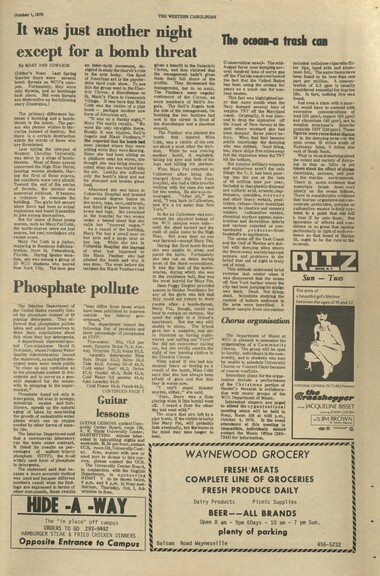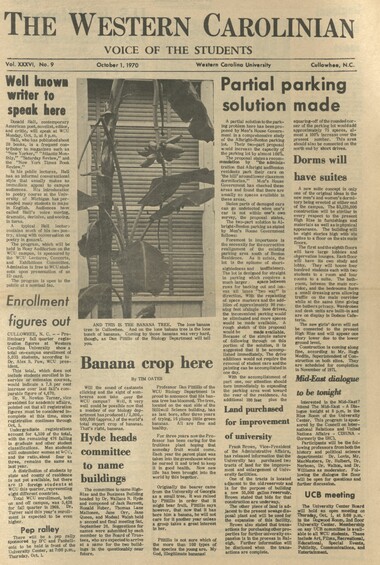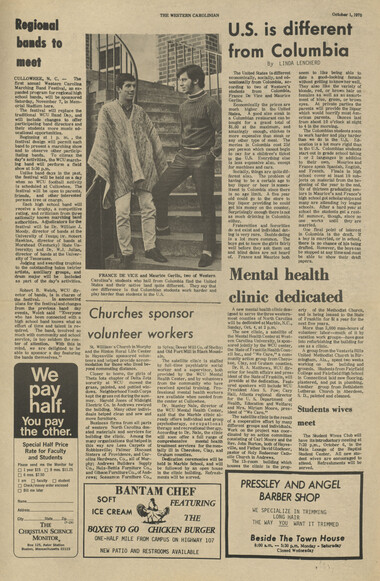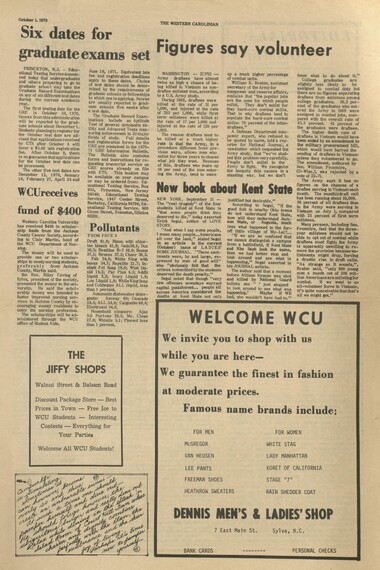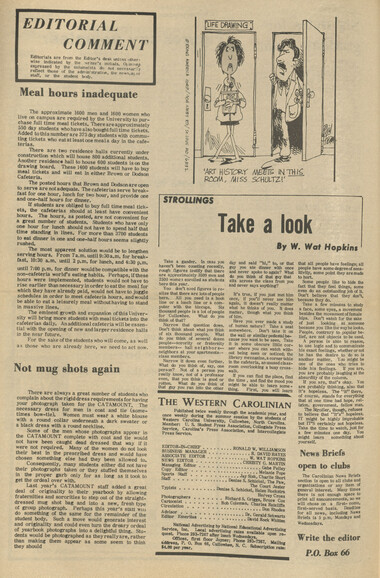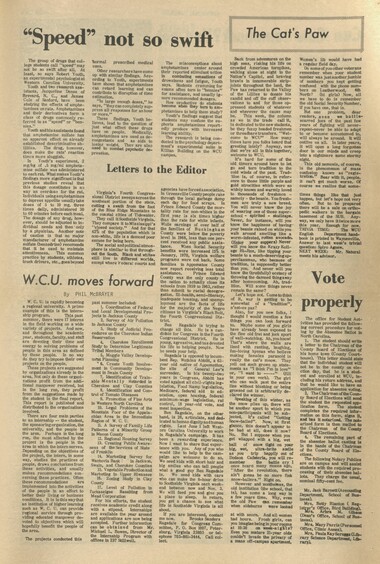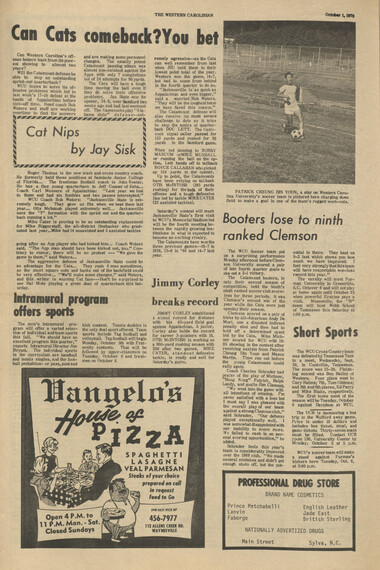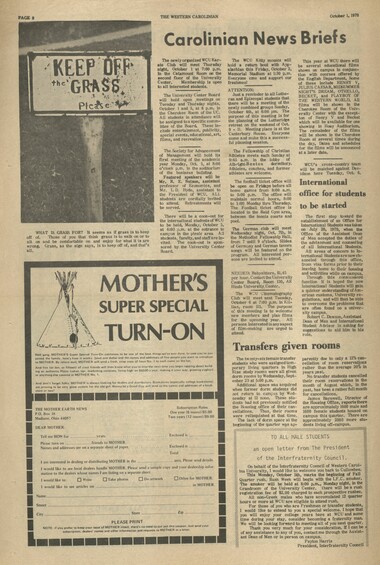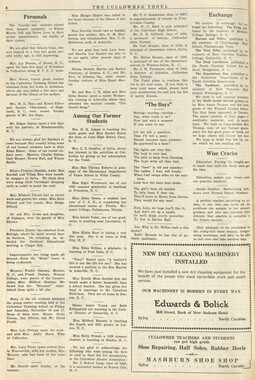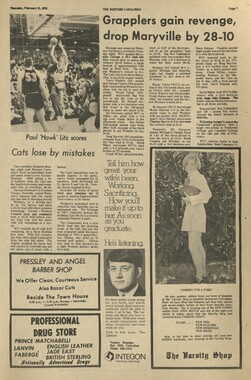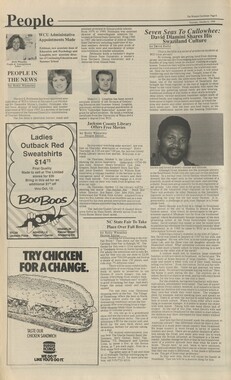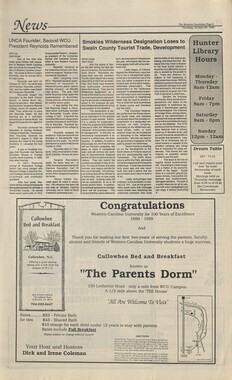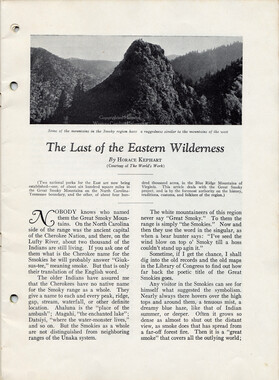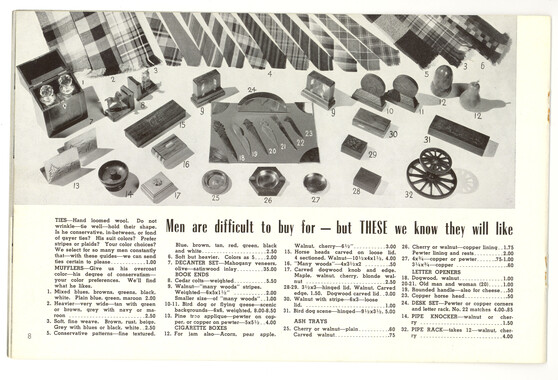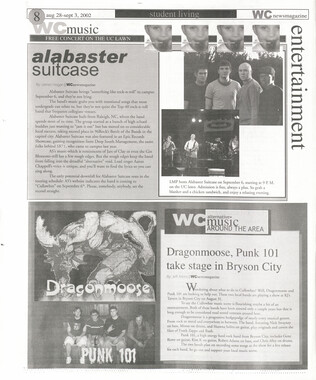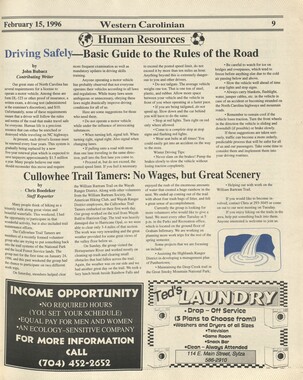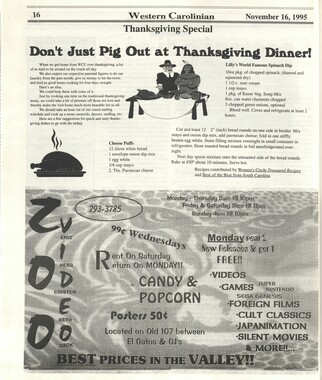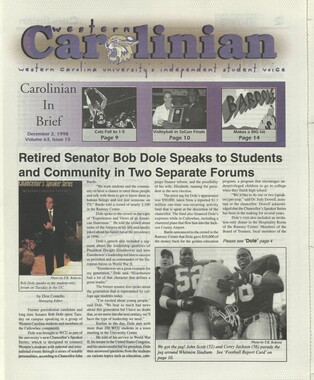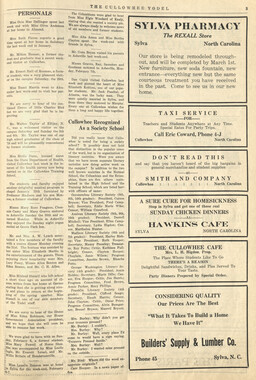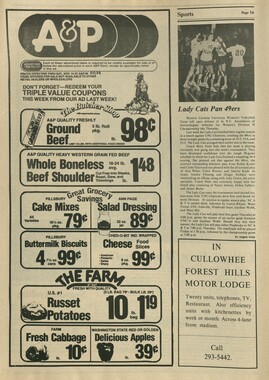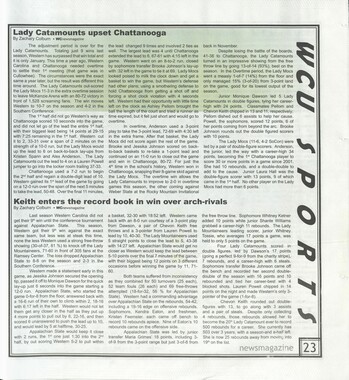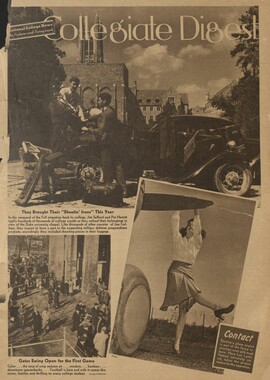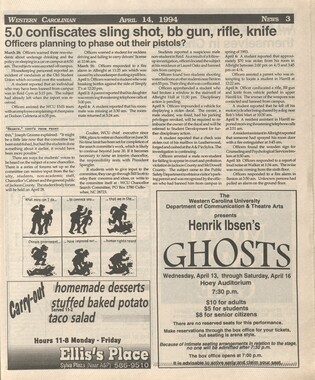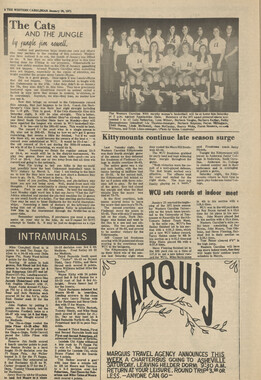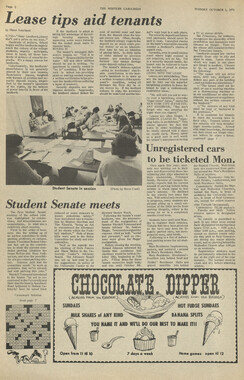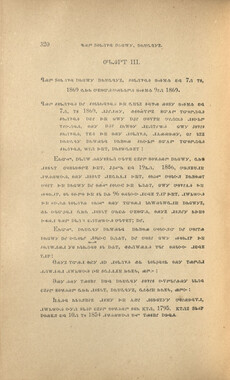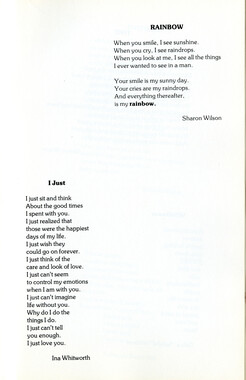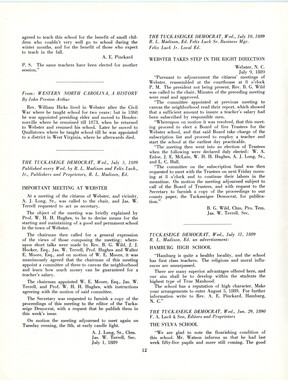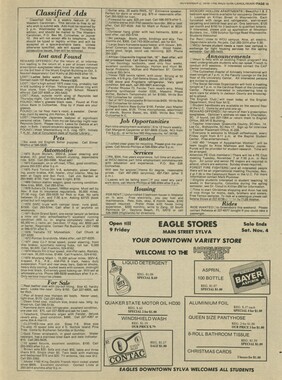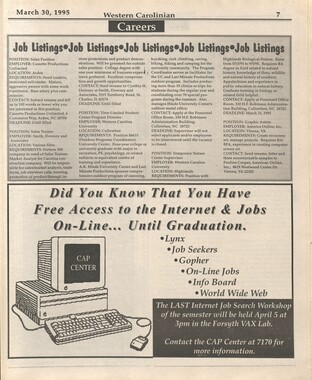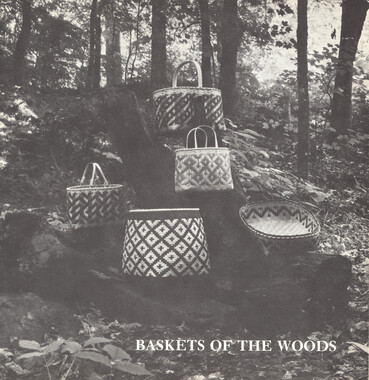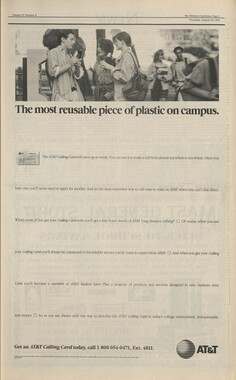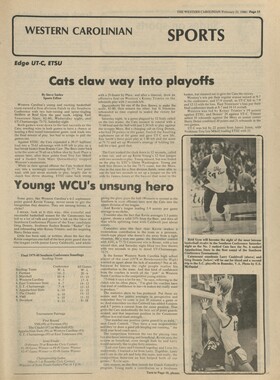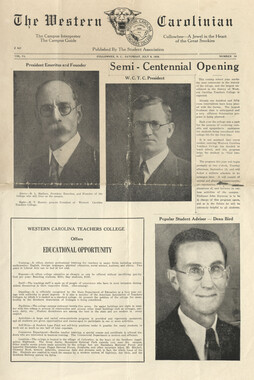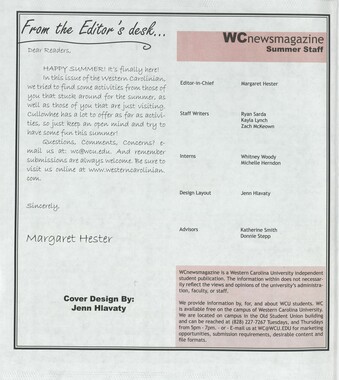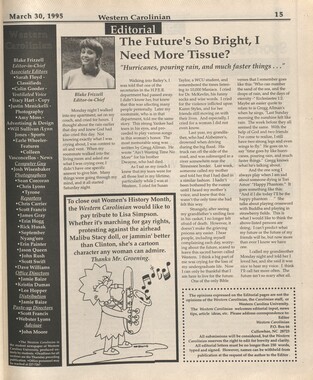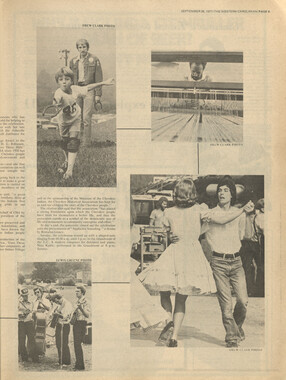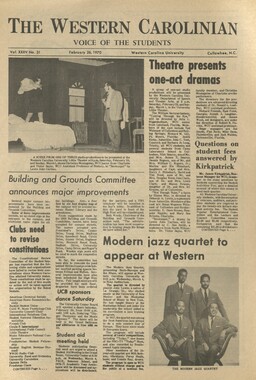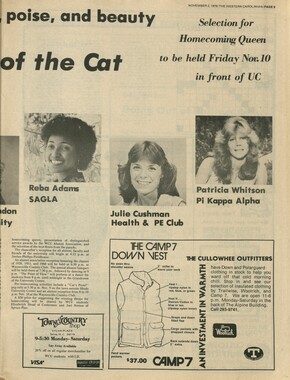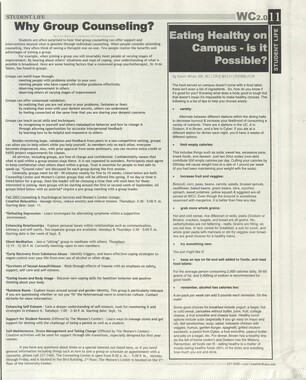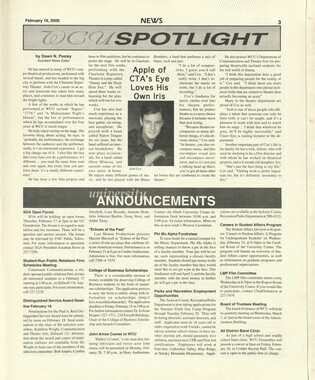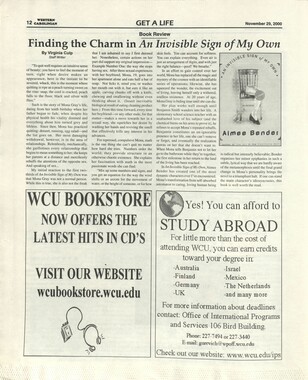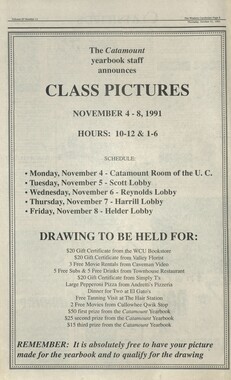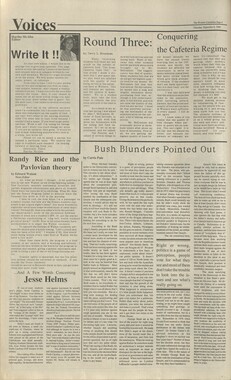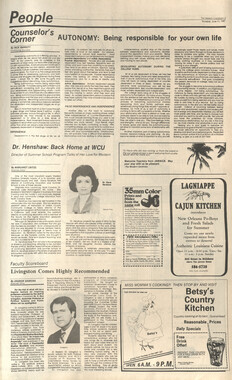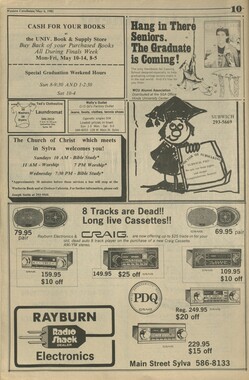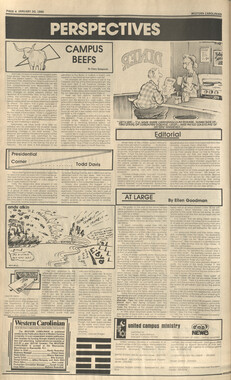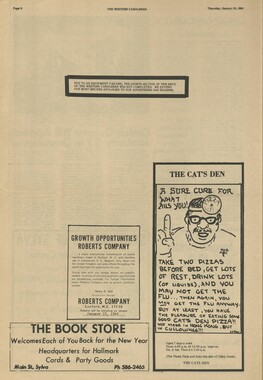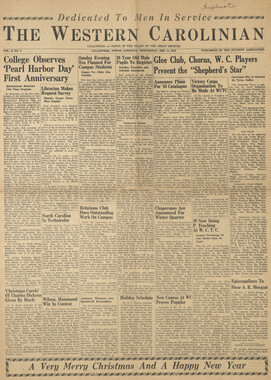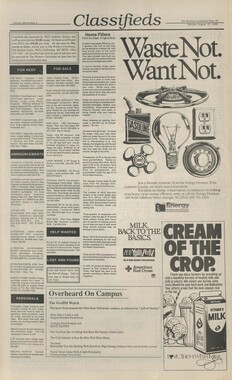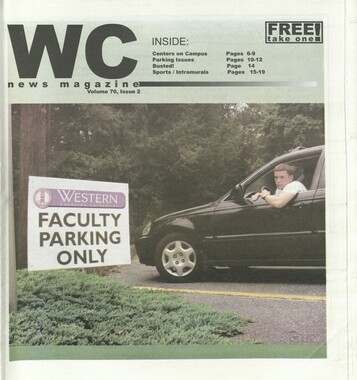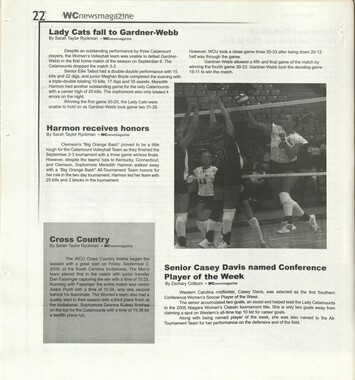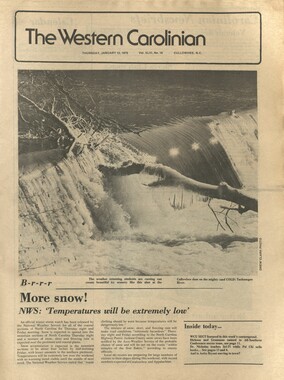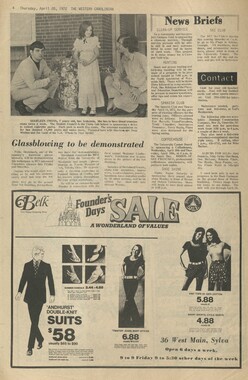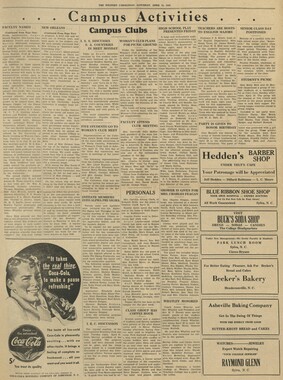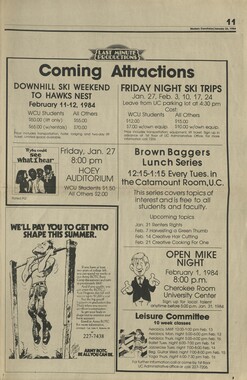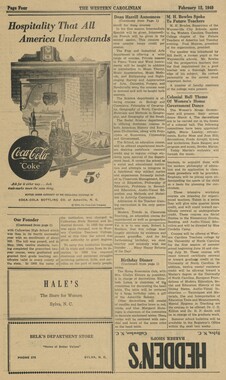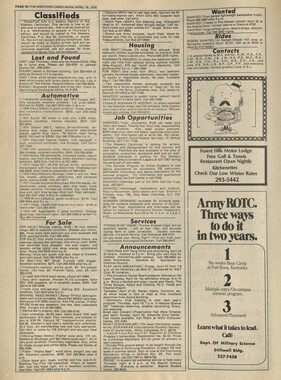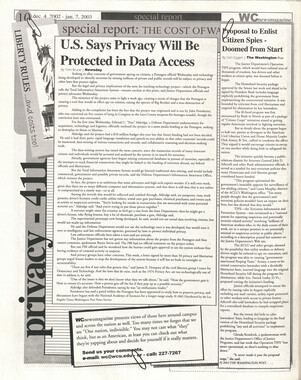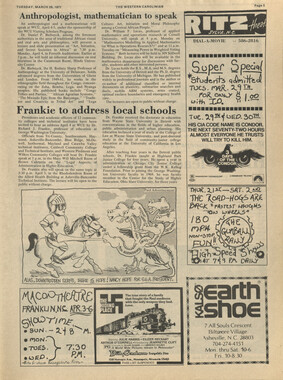Western Carolina University (20)
View all
- Canton Champion Fibre Company (2308)
- Cherokee Traditions (291)
- Civil War in Southern Appalachia (165)
- Craft Revival (1942)
- Great Smoky Mountains - A Park for America (2946)
- Highlights from Western Carolina University (430)
- Horace Kephart (941)
- Journeys Through Jackson (159)
- LGBTQIA+ Archive of Jackson County (85)
- Oral Histories of Western North Carolina (314)
- Picturing Appalachia (6798)
- Stories of Mountain Folk (413)
- Travel Western North Carolina (160)
- Western Carolina University Fine Art Museum Vitreograph Collection (129)
- Western Carolina University Herbarium (92)
- Western Carolina University: Making Memories (708)
- Western Carolina University Publications (2412)
- Western Carolina University Restricted Electronic Theses and Dissertations (146)
- Western North Carolina Regional Maps (71)
- World War II in Southern Appalachia (131)
University of North Carolina Asheville (6)
View all
- Western Carolina College (199)
- Western Carolina Teachers College (239)
- Western Carolina University (1897)
- Allanstand Cottage Industries (0)
- Appalachian National Park Association (0)
- Bennett, Kelly, 1890-1974 (0)
- Berry, Walter (0)
- Brasstown Carvers (0)
- Cain, Doreyl Ammons (0)
- Carver, George Washington, 1864?-1943 (0)
- Cathey, Joseph, 1803-1874 (0)
- Champion Fibre Company (0)
- Champion Paper and Fibre Company (0)
- Cherokee Indian Fair Association (0)
- Cherokee Language Program (0)
- Crittenden, Lorraine (0)
- Crowe, Amanda (0)
- Edmonston, Thomas Benton, 1842-1907 (0)
- Ensley, A. L. (Abraham Lincoln), 1865-1948 (0)
- Fromer, Irving Rhodes, 1913-1994 (0)
- George Butz (BFS 1907) (0)
- Goodrich, Frances Louisa (0)
- Grant, George Alexander, 1891-1964 (0)
- Heard, Marian Gladys (0)
- Kephart, Calvin, 1883-1969 (0)
- Kephart, Horace, 1862-1931 (0)
- Kephart, Laura, 1862-1954 (0)
- Laney, Gideon Thomas, 1889-1976 (0)
- Masa, George, 1881-1933 (0)
- McElhinney, William Julian, 1896-1953 (0)
- Niggli, Josephina, 1910-1983 (0)
- North Carolina Park Commission (0)
- Osborne, Kezia Stradley (0)
- Owens, Samuel Robert, 1918-1995 (0)
- Penland Weavers and Potters (0)
- Rhodes, Judy (0)
- Roberts, Vivienne (0)
- Roth, Albert, 1890-1974 (0)
- Schenck, Carl Alwin, 1868-1955 (0)
- Sherrill's Photography Studio (0)
- Smith, Edward Clark (0)
- Southern Highland Handicraft Guild (0)
- Southern Highlanders, Inc. (0)
- Stalcup, Jesse Bryson (0)
- Stearns, I. K. (0)
- Thompson, James Edward, 1880-1976 (0)
- United States. Indian Arts and Crafts Board (0)
- USFS (0)
- Vance, Zebulon Baird, 1830-1894 (0)
- Weaver, Zebulon, 1872-1948 (0)
- Western Carolina University. Mountain Heritage Center (0)
- Whitman, Walt, 1819-1892 (0)
- Wilburn, Hiram Coleman, 1880-1967 (0)
- Williams, Isadora (0)
- 1920s (57)
- 1930s (69)
- 1940s (114)
- 1950s (66)
- 1960s (314)
- 1970s (599)
- 1980s (406)
- 1990s (379)
- 2000s (282)
- 2010s (99)
- 1600s (0)
- 1700s (0)
- 1800s (0)
- 1810s (0)
- 1820s (0)
- 1830s (0)
- 1840s (0)
- 1850s (0)
- 1860s (0)
- 1870s (0)
- 1880s (0)
- 1890s (0)
- 1900s (0)
- 1910s (0)
- 2020s (0)
- Jackson County (N.C.) (2387)
- Appalachian Region, Southern (0)
- Asheville (N.C.) (0)
- Avery County (N.C.) (0)
- Blount County (Tenn.) (0)
- Buncombe County (N.C.) (0)
- Cherokee County (N.C.) (0)
- Clay County (N.C.) (0)
- Graham County (N.C.) (0)
- Great Smoky Mountains National Park (N.C. and Tenn.) (0)
- Haywood County (N.C.) (0)
- Henderson County (N.C.) (0)
- Knox County (Tenn.) (0)
- Knoxville (Tenn.) (0)
- Lake Santeetlah (N.C.) (0)
- Macon County (N.C.) (0)
- Madison County (N.C.) (0)
- McDowell County (N.C.) (0)
- Mitchell County (N.C.) (0)
- Polk County (N.C.) (0)
- Qualla Boundary (0)
- Rutherford County (N.C.) (0)
- Swain County (N.C.) (0)
- Transylvania County (N.C.) (0)
- Watauga County (N.C.) (0)
- Waynesville (N.C.) (0)
- Yancey County (N.C.) (0)
- Newsletters (510)
- Publications (documents) (1902)
- Aerial Photographs (0)
- Aerial Views (0)
- Albums (books) (0)
- Articles (0)
- Artifacts (object Genre) (0)
- Bibliographies (0)
- Biography (general Genre) (0)
- Cards (information Artifacts) (0)
- Clippings (information Artifacts) (0)
- Copybooks (instructional Materials) (0)
- Crafts (art Genres) (0)
- Depictions (visual Works) (0)
- Design Drawings (0)
- Drawings (visual Works) (0)
- Envelopes (0)
- Exhibitions (events) (0)
- Facsimiles (reproductions) (0)
- Fiction (general Genre) (0)
- Financial Records (0)
- Fliers (printed Matter) (0)
- Glass Plate Negatives (0)
- Guidebooks (0)
- Internegatives (0)
- Interviews (0)
- Land Surveys (0)
- Letters (correspondence) (0)
- Manuscripts (documents) (0)
- Maps (documents) (0)
- Memorandums (0)
- Minutes (administrative Records) (0)
- Negatives (photographs) (0)
- Newspapers (0)
- Notebooks (0)
- Occupation Currency (0)
- Paintings (visual Works) (0)
- Pen And Ink Drawings (0)
- Periodicals (0)
- Personal Narratives (0)
- Photographs (0)
- Plans (maps) (0)
- Poetry (0)
- Portraits (0)
- Postcards (0)
- Programs (documents) (0)
- Questionnaires (0)
- Relief Prints (0)
- Sayings (literary Genre) (0)
- Scrapbooks (0)
- Sheet Music (0)
- Slides (photographs) (0)
- Songs (musical Compositions) (0)
- Sound Recordings (0)
- Specimens (0)
- Speeches (documents) (0)
- Text Messages (0)
- Tintypes (photographs) (0)
- Transcripts (0)
- Video Recordings (physical Artifacts) (0)
- The Reporter, Western Carolina University (510)
- WCU Students Newspapers Collection (1843)
- A.L. Ensley Collection (0)
- Appalachian Industrial School Records (0)
- Appalachian National Park Association Records (0)
- Axley-Meroney Collection (0)
- Bayard Wootten Photograph Collection (0)
- Bethel Rural Community Organization Collection (0)
- Blumer Collection (0)
- C.W. Slagle Collection (0)
- Canton Area Historical Museum (0)
- Carlos C. Campbell Collection (0)
- Cataloochee History Project (0)
- Cherokee Studies Collection (0)
- Daisy Dame Photograph Album (0)
- Daniel Boone VI Collection (0)
- Doris Ulmann Photograph Collection (0)
- Elizabeth H. Lasley Collection (0)
- Elizabeth Woolworth Szold Fleharty Collection (0)
- Frank Fry Collection (0)
- George Masa Collection (0)
- Gideon Laney Collection (0)
- Hazel Scarborough Collection (0)
- Hiram C. Wilburn Papers (0)
- Historic Photographs Collection (0)
- Horace Kephart Collection (0)
- Humbard Collection (0)
- Hunter and Weaver Families Collection (0)
- I. D. Blumenthal Collection (0)
- Isadora Williams Collection (0)
- Jesse Bryson Stalcup Collection (0)
- Jim Thompson Collection (0)
- John B. Battle Collection (0)
- John C. Campbell Folk School Records (0)
- John Parris Collection (0)
- Judaculla Rock project (0)
- Kelly Bennett Collection (0)
- Love Family Papers (0)
- Major Wiley Parris Civil War Letters (0)
- Map Collection (0)
- McFee-Misemer Civil War Letters (0)
- Mountain Heritage Center Collection (0)
- Norburn - Robertson - Thomson Families Collection (0)
- Pauline Hood Collection (0)
- Pre-Guild Collection (0)
- Qualla Arts and Crafts Mutual Collection (0)
- R.A. Romanes Collection (0)
- Rosser H. Taylor Collection (0)
- Samuel Robert Owens Collection (0)
- Sara Madison Collection (0)
- Sherrill Studio Photo Collection (0)
- Smoky Mountains Hiking Club Collection (0)
- Stories of Mountain Folk - Radio Programs (0)
- Venoy and Elizabeth Reed Collection (0)
- WCU Gender and Sexuality Oral History Project (0)
- WCU Mountain Heritage Center Oral Histories (0)
- WCU Oral History Collection - Mountain People, Mountain Lives (0)
- Western North Carolina Tomorrow Black Oral History Project (0)
- William Williams Stringfield Collection (0)
- Zebulon Weaver Collection (0)
- College student newspapers and periodicals (1872)
- African Americans (0)
- Appalachian Trail (0)
- Artisans (0)
- Cherokee art (0)
- Cherokee artists -- North Carolina (0)
- Cherokee language (0)
- Cherokee pottery (0)
- Cherokee women (0)
- Church buildings (0)
- Civilian Conservation Corps (U.S.) (0)
- Dams (0)
- Dance (0)
- Education (0)
- Floods (0)
- Folk music (0)
- Forced removal, 1813-1903 (0)
- Forest conservation (0)
- Forests and forestry (0)
- Gender nonconformity (0)
- Great Smoky Mountains National Park (N.C. and Tenn.) (0)
- Hunting (0)
- Landscape photography (0)
- Logging (0)
- Maps (0)
- Mines and mineral resources (0)
- North Carolina -- Maps (0)
- Paper industry (0)
- Postcards (0)
- Pottery (0)
- Railroad trains (0)
- Rural electrification -- North Carolina, Western (0)
- School integration -- Southern States (0)
- Segregation -- North Carolina, Western (0)
- Slavery (0)
- Sports (0)
- Storytelling (0)
- Waterfalls -- Great Smoky Mountains (N.C. and Tenn.) (0)
- Weaving -- Appalachian Region, Southern (0)
- Wood-carving -- Appalachian Region, Southern (0)
- World War, 1939-1945 (0)
- Text (2412)
- MovingImage (0)
- Sound (0)
- StillImage (0)
Western Carolinian Volume 36 Number 09
Item
Item’s are ‘child’ level descriptions to ‘parent’ objects, (e.g. one page of a whole book).
-
-
October 1,1970 THE WESTERN CAROLINIAN It was just another night except for a bomb threat The oceoi-a trash can By MARY ANN EDWARDS (Editor's Note: Last Spring Quarter there were several bomb threats on WCU's campus. Fortunately, they were only threats, and no bombings took place. But even threats are destructive as the foUowing story illustrates.) The primary difference between a bombing and a bomb- threat Is the Intent The per- son who phones wishes to terrorize instead of destroy. But there is a certain destruction within the minds of those who are threatened. Last spring the campus of Western Carolina University was taken by a siege of bomb~ threats. Most of these scares concerned the High Rise Dorm, housing women students. During the first of these scares, the residents were very afraid. Toward the end of the series of threats, the tension was somewliat relieved. It became a nuisance to evacuate the building. The girls felt secure since there had been no actual explosions and found it possible to joke among themselves. But for some of these young women, such as Mary Pat Cobb, the bomb-scares were not just scares, but real reminders of a recent event Mary Pat Cobb Is a junior, majoring in Business Adminis ■ tration, from St Petersburg, Florida. During Easter vacation, she was among a group of 35 WCU students who toured New York City. The tour was an inter-Iaith movement, designed to study the church's role in the arts today. One facet of American art Is the psychedelic hard rock show. To see this the group went to the Electric Circus, a discotheque on St Mark's Place in Greenwich Village. It was here that Miss Cobb was the victim of a pipe bomb — perhaps another new form of American art 'It was on a Sunday night," Mary Pat easily recalls. "We were the only straights there. Mostly it was hippies, Hell's Angels and Black Panthers." She reported that the bomb had been planted where they were sitting while they were dancing. Since she had been sitting on a platform near hot wires, she thought she was being electrocuted when she was hurled into the air. Luckily she suffered only the bomb's blast and not its sharpnel and broken glass load. Afterward she was taken to Columbia Hospital and treated for second degree bums on the arms, legs, neck, and truck, and third degree burns on the arms and legs. She remained in the hospital for two weeks under a tented sheet that she calls her "covered wagon." As a result of the bombing, Mary Pat has a small scar on her arm and a large scar on her leg. While she was in Columbia Hospital she learned of what had happened to the Black Panther who had planted the bomb and why it was done. The week before the incident the Black Panthers had Phosphate pollute The Interior Department of the United States recently listed the phosphate content of 48 popular detergents. They affirmed that phosphates pollute lakes and asked housewives to draw their conclusions about this when they buy detergents. A department statement quoted Commissioner David D, Dominick, whose Federal Water Quality Administration issued the statement, as saying the detergent tests were made public "to clear up any confusion as to the phosphate content in detergents and to serve as a general standard for the housewife in shopping in the supermarket" Phosphate found not only in datergents, but also in sewage, industrial wastes and fertilizers, speeds up the natural aging of lakes by nourishing the growth of undesirable water plants which use up oxygen needed by other forms of aquatic life. The Interior Department said that a commercial laboratory ran the tests under contract It listed its results as percentages of sodium tripoiy phosphate (STPP), the most widely used form of phosphate in detergents. The statement said that because a more accurate method was used and because different numbers result when the findings are expressed in terms of other compounds, these results "may differ from those which have been published by sources outside the federal government" The department issued the following list of products and their percentage of phosphates at STPP; Pre-soaks: Biz, 73.9 per cent; Enzyme Brion 71.4; Am- way Trizyme 71.2; Avion 63.2. Laundry detergents: Blue Rain Drops 63.2; Salvo 56.6 Tide 49.8: Amway SA-8 49.3; Cold water Surf 48.2; Drive 47.4; Oxydol 46.6, Bold 45.4; Cold Water All powder 45.4; Ajax Laundry 44.6: Cold Power 44.6; Punch 44.2; CONTINUED PAGE 7 Guitar lessons GUITAR LESSONS: contact University Center Board, room 130, A. K. Hinds University Center. BABYSITTERS: anyone interested in babysitting nights and weekends, $1.50 per hour, contact UCB, room 130, University Center, AJso, anyone with new or used toys to donate to ihis service, please contact the UCB, The University Center Board, in conjunction with the English Department, is sponsoring HENRY V to be shown twice, 6 p.m. and 9 p.m. in Hoey auditorium, Thursday, Oct 1. Admission is free. A -WAY The "in place" off campus ORDERS TO GO 293-9492 HAMBURGER STEAK & FRIED CHICKEN DINNERS Opposite Entrance to Campus given a benefit in the Eelectrlc Circus, and they claimed that the management hadn't given them their full share of the profits. They threatened the management, but to no avail. The Panthers were regular customers of the Circus, as were members of Hell's Angels. The Hell's Angels took the side of the management On bombing the two factions had met in the street in front of the discotheque and a shootout ensued. The Panther wlio planted the bomb that Injured Miss Cobb, was a victim of his own art about a week after the Incident While he was making another bomb, It exploded, taking his arm and both of his legs and killing his partner. • When Mary Pat returned to Cullowhee after being discharged from the New York hospital, she had a little trouble walking with the cane she used for two weeks. Bu she was encouraged. "After all," she said, "I was back In Cullowhee, and It's a lot safer than New York." So far as Cullowhee was concerned the physical beings of the WCU campus were safe • ■ until the shed burned and the rash of calls came to the High Rise. But even then no one was harmed -except Mary Pat During the first bomb threat she was unable to sleep and paced the halls. Fortunately she was out on dates during most of the dorm evacuations. It was the last of the bomb- scares, during which she was in the residence hall, that was the most horrid for Mary Pat Dean Peggy Ziegler provided spaces in Helder Residence for any of the girls who felt that they could not return to their rooms after a bomb-threat Mary Pat, though, could not bear to remain on campus. She spent the night in a friend's apartment But she was still unable to sleep. The friend gave her a sedative, and she is reported as having nights mares and calling out "Fire!" She did not remember calling out, but she vividly recalls the sight of her burning clothes in the Electric Circus, When asked if she had any unusual fears or feeling as a result of the bomb, Miss Cobb says that she has always been afraid of guns and that this fear is worse now. "I can't stand thunder storms, either," she said, "Also, there was a flute playing when It (the bomb) went off. I heard a flute the other day and went wild." The scars that are left by a pipe bomb, if the victim is lucky like Mary Pat, will probably fade eventually, but the burns in the mind may take longer to heal. (Conservation news)- The mid - August furor over dumping several hundred tons of nerve gas off the Florida coast overlooked the fact that the United States has been using the oceans for years as a trash can for noxious wastes. This fact was highlighted lat er that same month when the Navy dumped several tons of surplus TNT off the Maryland coast Originally, It was planned to drop the explosive off the coast of New Jersey at the spot where mustard gas had been dumped three years be ■ fore. When that fact became public knowledge the dumping site was shifted. Good thing, too, since ships five miles away felt the explosion when the TNT hit the bottom. But surplus military weapons and explosives aren't the only things the U, S. has been pouring into the sea at the rate of 48 million tons per year. Included in that ghastly disposal are sulfuric acid, arsenic, nap - thenates, cyanides, mercury and other heavy metals, pesticides, refuse—from municipal sewage to plastics and cannery wastes; radioactive wastes, chemical warfare agents, construction and demolition debris and various rejected or contaminated product s—from foodstuffs to appliances. The ocean off the East Coast and the Gulf of Mexico are dotted with dumping sites where the throw-away society has cast poisons and problems In the belief that out of sight is truly out of mind, This attitude underwent brief revision last winter when it was discovered that the ocean off New York harbor where the city had been jumping Its sludge was dead. Dead, Not dying; dead. Scientists studying the content of bottom sediment in the area were horrified. A bottom sample from one station Chorus organisation The Department of Music at WCU is pleased to announce the organization of a Community Chorus, The group will be open to faculty, Individuals in the community, and to students who may be unable to schedule University Chorus or Concert Choir because of course conflicts, Immediate plans for the organization include a performance of the Christmas portion of Handel's Messiah in collaboration with music groups of the WCU Department of Music. Interested singers are urged to attend the organizational meeting which will be held in Hoey, Room 108 at 4:00 p.m., October 4, 1970. In the event attendance at this meeting is impossible, individuals should contact the Music Office (293- 7242) for information. included cellulose cigarette filter tips, band aids and aluminum foil. The same items have been found to be less than one part per million. A concentration of 2.5 ppm Is usually considered essential for marine life. In fact, nothing live was found. And even a clam with a snorkel would have to contend with excessive concentrations of lead (151 ppm), copper (60 ppm) and chromium (40 ppm), not to mention everyone's favorite pesticide DDT Q50ppm). These figures were recorded at Station 59 in the dumping area—in the open ocean 10 miles south of Rockaway Inlet, 9 miles due east of Sandy Hook. What is most disturbing about the extent and variety of dumping is that so little is yet known about the effect of sludge chemicals, poisons, and junk on the marine environment There is some evidence that materials break down very slowly on the ocean bottom. There Is considerable evidence that marine organisms can concentrate pesticides, poisons or radioactive wastes in their systems to a point that can kill a man If he eats them. But ignorance of effects and conditions is so great that caution particularly in light of such evidence as that found at Station 59, ought to be the rule at the moment Sun — Tues The story of a beautiful girl's lifetime between the ages of 19 and 22. NATIONAL GENERAL PICTURES Presents the JACQUELINE BISSET ,»«.™, JOSEPH COTTEN .3 JIM BROWN Aj Tommy Marcott »m © „„„„„„„„„,„„„„„„„„„„* | Balsam WAYNEWOOD GROCERY FRESH MEATS COMPLETE LINE OF GROCERIES FRESH PRODUCE DAILY Dairy Products Picnic Supplies BEER ALL BRANDS Open 8 am - 9pm 6Days - 10 am - 7 pm Sun. plenty of parking Road Waynesville 456-5232
Object
Object’s are ‘parent’ level descriptions to ‘children’ items, (e.g. a book with pages).
-
The Western Carolinian is Western Carolina University's student-run newspaper. The paper was published as the Cullowhee Yodel from 1924 to 1931 before changing its name to The Western Carolinian in 1933.
-
